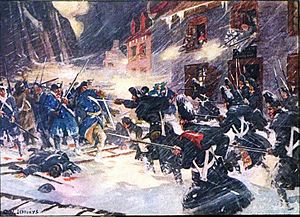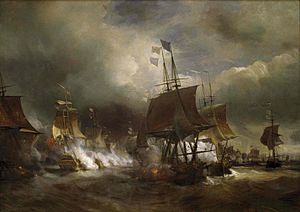Sir John Hamilton, 1st Baronet, of Marlborough House facts for kids
Quick facts for kids
Sir
John Hamilton
|
|
|---|---|
| Born | 21 February 1726 |
| Died | 24 January 1784 (aged 57) |
| Allegiance | Kingdom of Great Britain |
| Service/ |
Royal Navy |
| Years of service | 1740–1784 |
| Rank | Captain |
| Commands held | HMS Cormorant HMS Zephyr HMS Merlin HMS Active HMS Lizard HMS Hector HMS Grafton |
| Battles/wars | |
| Spouse(s) |
Cassandra Agnes Chamberlayne
(m. 1763–1784) |
| Children | Sir Charles Hamilton Sir Edward Hamilton |
Sir John Hamilton (born 21 February 1726 – died 24 January 1784) was an important officer in the Royal Navy during the 1700s. He started his naval career quite young, joining the navy in 1740. Over his career, he fought in major conflicts like the War of Jenkins' Ear, the Seven Years' War, and the American Revolutionary War. He became known for his bravery and leadership, especially during the Siege of Quebec. For his service, he was given the special title of Baronet. He commanded several ships, including the impressive HMS Hector, and faced many challenges at sea, from fierce battles to dangerous storms.
Contents
Early Life and Family
John Hamilton was born on February 21, 1726. His parents were John Hamilton and Mary Wright. He had one sister named Mary, who was born in 1728. His family was very old and had a long history, even dating back to the time of William the Conqueror in 1066. They were also related to some important noble families in Britain.
John Hamilton began his career in the Royal Navy on September 22, 1740. He started as a captain's servant on the 60-gun ship, HMS Rippon. This ship sailed to the West Indies as part of a large fleet.
First Battles and Promotions
Hamilton saw his first battle on January 7, 1741. His ship, Rippon, was part of a group of ships that fought a French squadron. They thought the French ships were Spanish, but the battle ended without a clear winner. Later that year, he fought in the Battle of Cartagena de Indias, which was not successful for the British.
After this, he moved to HMS Alderney and took part in the Invasion of Cuba in August. This invasion also failed. In October 1741, he transferred to the frigate HMS Success.
He was promoted to midshipman on Success in October 1742. He served in places like New England and off Lisbon. In 1743, he moved to the large ship HMS Princess Royal. By December 1743, he was on the frigate HMS Bideford and sailed to the West Indies in 1744.
He became a midshipman again on HMS Tartar in May 1744, serving near South Carolina. He was promoted to acting lieutenant on Tartar in January 1746, and his rank was made permanent in January 1747.
Serving as a Lieutenant
In February 1747, Hamilton left Tartar and became the second lieutenant on HMS Winchester. He served on this ship until August 1749. For a few years, he did not have a ship.
In February 1755, he became the third lieutenant on HMS Ramillies. Later that year, in October, he moved to HMS Colchester and became her first lieutenant.
The Seven Years' War began, and in May 1756, Colchester and another British ship fought two French warships. The battle lasted about six hours, and both sides were too damaged to continue fighting.
Colchester helped escort East India Company ships in 1757 and 1758. In 1759, she joined Admiral Sir Edward Hawke's fleet, blocking the port of Port Louis. Hamilton stayed on Colchester until January 1760. He then became first lieutenant of HMS Prince Edward. This ship sailed to the Levant in 1761 to protect merchant ships.
In January 1762, he transferred to HMS Royal William. However, his time on this ship was short. On April 7, 1762, John Hamilton was promoted to commander.
Leading His Own Ships
First Commands
As a commander, Hamilton received his first ship, the 8-gun fireship HMS Cormorant. He commanded her until December 1762.
In April 1764, he was given command of the 10-gun sloop HMS Zephyr. He sailed her to Newfoundland in May. In February 1766, he moved to the 18-gun sloop HMS Merlin. He returned to Newfoundland on Merlin and served there until May 1768, when he was promoted to post captain.
Fighting in the American Revolution
His first command as a post captain was the 28-gun frigate HMS Active. He commanded her until March 1771, but she did not see any battles during this time.
Hamilton was on half pay (meaning he was still an officer but not actively serving) for four years. Then, in June 1775, he was ordered to command the 28-gun frigate HMS Lizard. This was because the American Revolutionary War had just begun.
He sailed to North America in August 1775. In December, during the Siege of Quebec, Hamilton played a crucial role. He brought Lizard's guns and supplies ashore to help defend the city. He then took command of a group of sailors and fought on land during the battle. His actions greatly helped the British win the siege.
For his bravery at Quebec, Hamilton was chosen to carry the news of the victory back to Britain. He sailed on the sloop HMS Hunter. As a reward for his service, the British parliament thanked him, and he was made a baronet on June 6, 1776. This was a special honor.
Big Battles and Storms at Sea
After leaving Lizard, Hamilton took command of a brand new, powerful 74-gun ship of the line, HMS Hector, in July 1776. He joined the Channel Fleet in December.
On July 27, 1778, he fought in the Battle of Ushant. Hector was part of the front section of the British fleet in this battle, which ended without a clear winner.
In 1780, Hamilton sailed with Admiral Sir George Rodney's fleet towards Gibraltar. However, Hector was sent to the West Indies to protect a large group of over two hundred merchant ships. Because of this, Hamilton missed another important battle.
In March, Hector joined a squadron of ships in the West Indies. In June, Hector was part of a smaller group of British ships that met a much larger French force off Bermuda. The British ships managed to keep the French at bay all day and then safely retreat.
In October 1780, Hector and other ships were caught in the Great Hurricane of 1780. This was a massive storm. Hector lost all her masts and was badly damaged, but Hamilton managed to get her safely to port. He had to throw most of the ship's guns overboard to keep her from sinking. He returned home from the West Indies at the end of that year.
His Final Years
Hamilton continued to command Hector until December 1782. He then took command of another 74-gun ship, HMS Grafton. He was supposed to sail to the East Indies Station to reinforce British forces there. However, in January 1783, while sailing through the Bay of Biscay, Grafton and other ships were hit by severe storms. Grafton lost all her masts and had to return home. The ship was taken out of service in April.
A month later, Hamilton returned to command Hector, which was now serving as a guardship at Portsmouth. For some time, Hamilton had been suffering from yellow fever, likely caught during his many trips to foreign lands. This illness made him very weak.
In December 1783, he was part of a naval court case, which made his health worse. On January 22, 1784, he had to give up his command of Hector. He died just two days later, on January 24, 1784, at the age of 57.
Family Life
John Hamilton married Cassandra Agnes Chamberlayne on October 4, 1763. She was the daughter of Edmund Chamberlayne. They had two sons, both of whom followed their father into the Royal Navy. They even served with him on his ship, Hector:
- Admiral Sir Charles Hamilton, 2nd Baronet (1767–1849): He inherited his father's special title when his father passed away.
- Admiral Sir Edward Hamilton, 1st Baronet (1772–1851): He was awarded his own special title in 1819.



